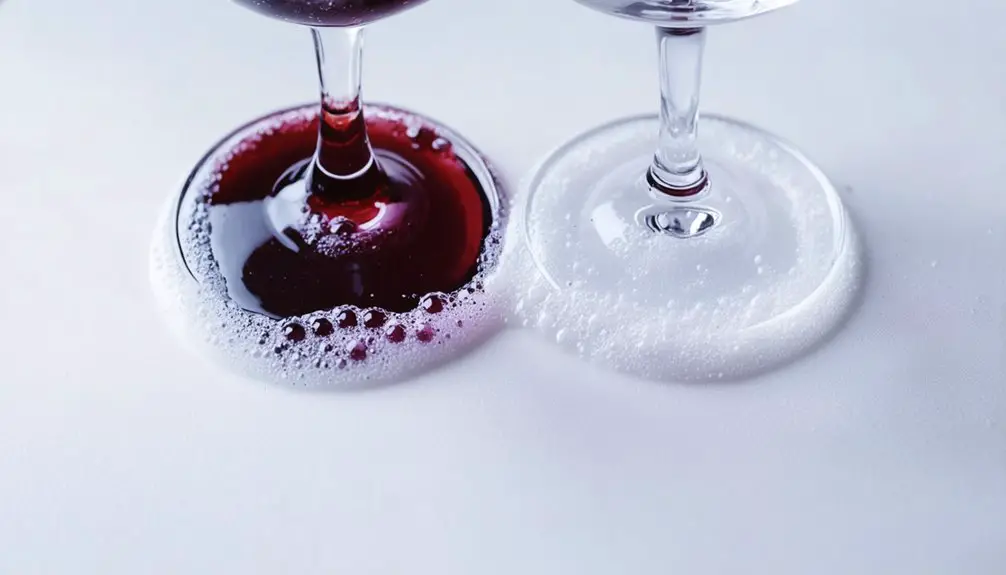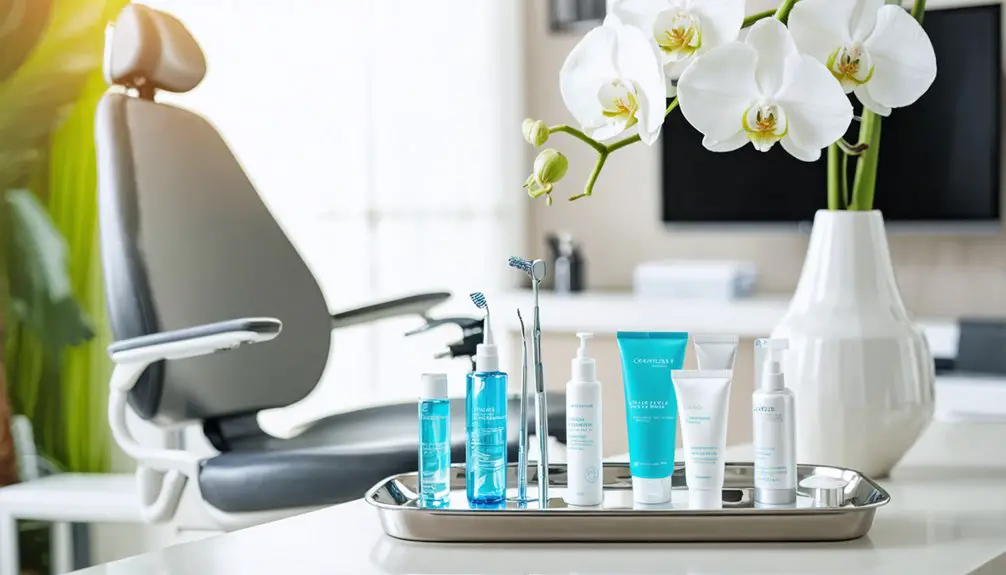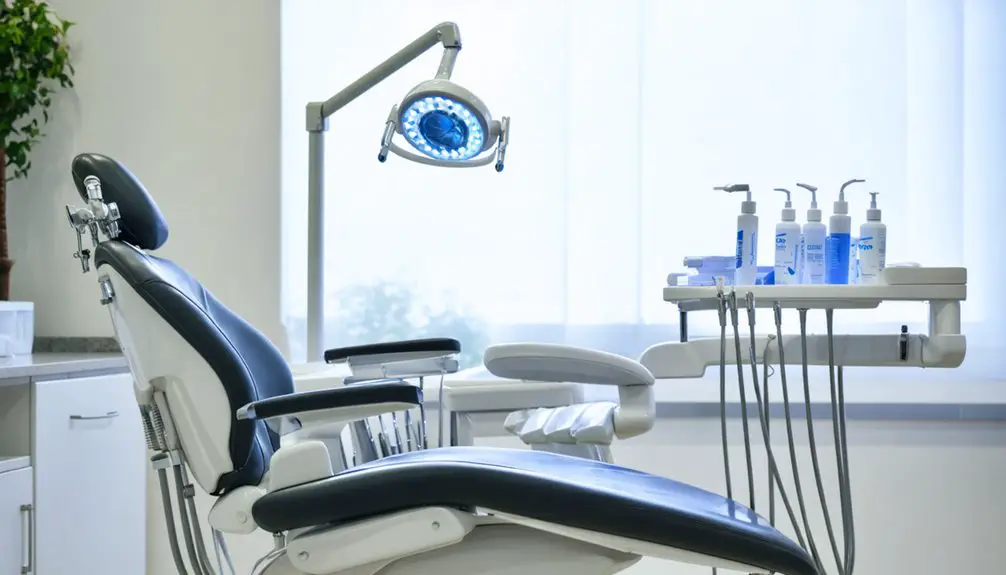To remove wine stains from your teeth, rinse thoroughly with water between sips and use specialized wine wipes to lift surface stains immediately. You can apply over-the-counter whitening strips or gels containing hydrogen peroxide, but wait 30 minutes after drinking before any treatment. Natural options include gentle brushing with activated charcoal or baking soda paste once weekly. For ideal protection, pair your wine with cheese and maintain consistent dental hygiene—these techniques are just the beginning of your stain-fighting arsenal.
Key Takeaways
- Use specialized wine wipes by gently wrapping them around fingers to remove surface stains while protecting tooth enamel.
- Apply over-the-counter whitening strips or gels containing hydrogen peroxide to safely eliminate wine stains within recommended treatment times.
- Create a natural whitening paste using baking soda and hydrogen peroxide, applying gently to stained areas.
- Rinse thoroughly with water between sips and wait 30 minutes before brushing to prevent stain penetration.
- Brush with activated charcoal 1-2 times weekly, followed by thorough rinsing to help lift wine stains.
Understanding Wine’s Impact on Tooth Enamel
While many wine enthusiasts focus on the beverage’s taste and aroma, wine’s chemical composition can greatly impact your dental health. When you drink wine, its acidic nature directly affects your tooth enamel, with white wines typically being more erosive than red varieties due to their lower pH levels. The presence of natural sugars encourages bacteria growth that can damage teeth.
You’ll find that wine acidity dissolves essential minerals like calcium and phosphate from your teeth’s protective layer. Research shows that exposure to red wine can actually help remove harmful bacteria from dental biofilm.
This enamel erosion doesn’t just affect your teeth’s appearance – it creates vulnerabilities that can lead to sensitivity and increased cavity risk. The process becomes more severe with frequent exposure, as repeated acid attacks progressively weaken your enamel structure.
If you’re serving wine regularly, you should know that both red and white varieties can cause significant demineralization, extending up to 60 micrometers into your enamel.
Immediate Steps to Prevent Wine Stains
To protect your teeth while enjoying wine, you’ll need to rinse frequently with water between sips to prevent stains from setting into your enamel.
The acidic nature of wine can weaken tooth enamel and increase vulnerability to staining over time.
Pairing your wine with protective foods like cheese and fibrous vegetables creates a natural barrier while stimulating saliva production that helps cleanse your teeth.
Using specialized wine wipes throughout your drinking session actively removes tannins and pigments before they can bond to your tooth surface.
Wait at least 30 minutes before brushing teeth after drinking wine to protect your enamel from damage.
Rinse While You Drink
Preventing wine stains on your teeth starts with proper rinsing techniques during consumption. As you drink wine, alternate each sip with water, swishing it around your mouth to flush away tannins and pigments before they adhere to your enamel. Hard cheeses can also provide excellent protection when consumed alongside wine.
For enhanced cleansing, opt for sparkling water, as its carbonation helps break down stubborn compounds while mechanically scrubbing your teeth surfaces. The sparkling benefits extend beyond basic cleaning – the effervescent action stimulates saliva production, which naturally neutralizes acidic conditions and protects your enamel. Consider pairing your wine with fiber-rich foods to increase saliva flow and naturally scrub away stains.
When serving wine, keep water readily available for guests and encourage regular rinsing throughout the evening. Remember not to brush immediately after drinking, as the acid-softened enamel needs 20-30 minutes to reharden.
Instead, rely on thorough rinsing and natural saliva production to minimize staining.
Pair With Protective Foods
Beyond rinsing practices, strategic food pairings can greatly reduce wine-related tooth staining. The cheese benefits are particularly significant, as casein proteins create a protective barrier over your enamel while calcium and phosphates help remineralize weakened areas. High fiber foods have been proven especially effective at preventing stains by increasing saliva flow.
You’ll maximize protection by serving cheese alongside wine throughout your gathering. Regular dental cleanings are essential to maintain bright teeth even with protective food pairings.
Smart vegetable choices can offer additional defense through their natural cleansing properties. Include fiber-rich options like broccoli, carrots, and celery, which stimulate saliva production and mechanically clean teeth while drinking.
For ideal protection, you can pair these crunchy vegetables with dairy products – their combined action helps neutralize acids and block pigments from adhering to tooth surfaces. This approach isn’t just effective for wine; it’s also beneficial when serving other staining beverages like tea.
Use Wine Wipes Effectively
When enjoying wine at social gatherings, wine wipes serve as your first line of defense against stubborn tooth stains. For ideal wine wipe benefits, use them immediately after drinking, before pigments and tannins bond with your enamel. Don’t wait until you get home to address the stains.
To maximize stain removal techniques, wrap the wipe around your finger and gently swipe all visible tooth surfaces. The specialized blend of ingredients, including baking soda and hydrogen peroxide, works to lift stains while protecting your enamel. The wipes are pH balanced formula that won’t damage your teeth’s protective layers. These wipes contain natural ingredients that make them gentle and safe for regular use.
You’ll find these portable wipes particularly convenient at restaurants and wine tastings where brushing isn’t practical. Their individually sealed packets fit discreetly in your pocket or purse, allowing for quick application whenever needed.
Remember to focus on areas where wine typically accumulates for the best results.
Professional Whitening Solutions and Treatments
Professional teeth whitening solutions offer considerably more potent and effective approaches to removing stubborn wine stains than over-the-counter products.
You’ll find two primary professional options: in-office treatments and take-home kits provided by your dentist.
In-office treatments deliver rapid results through stronger bleaching agents, often enhanced by light or heat activation. Your dentist will apply custom trays with professional-grade whitening solution directly to your teeth.
For added convenience, you can opt for dentist-prescribed take-home kits featuring custom-fitted trays and higher-concentration whitening agents than retail products. While these take longer to achieve results, they’re gentler on sensitive teeth.
For severe staining that doesn’t respond to whitening, consider veneers or composite bonding for a permanent solution.
Regular dental cleanings and polishing complement these treatments by preventing new stains from developing.
At-Home Whitening Products and Methods
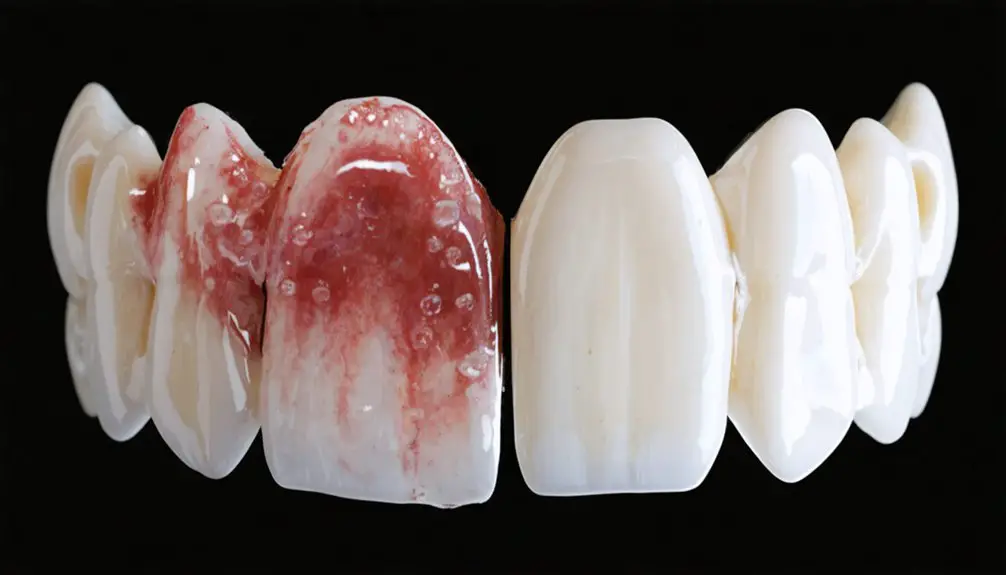
While over-the-counter whitening products containing peroxide offer convenient solutions for wine stains, you’ll need to follow application instructions carefully to achieve ideal results without damaging your teeth.
For a gentler approach, you can try natural remedies like oil pulling with coconut oil or brushing with activated charcoal, though these methods typically show more gradual effects.
You must avoid DIY treatments using acidic substances like lemon juice or vinegar, as these can erode your tooth enamel and cause lasting damage.
Over-the-Counter Whitening Solutions
Three primary types of over-the-counter teeth whitening products offer solutions for wine-stained teeth: strips, gels with trays, and whitening toothpaste.
For best results, look for products containing hydrogen peroxide or carbamide peroxide as active ingredients, as they’re most effective at removing surface stains.
You’ll typically see noticeable lightening within two weeks of proper use, though gel-filled trays may work faster.
While these OTC solutions aren’t as powerful as professional treatments, they’re generally safe when used as directed. You might experience temporary tooth sensitivity or gum irritation, but these effects usually subside quickly.
For lasting results, you’ll need maintenance treatments every few months, and it’s crucial to follow product instructions carefully to avoid uneven whitening or excessive sensitivity.
Natural Remedies Worth Trying
Looking to combat wine stains naturally? Several proven remedies can help restore your teeth’s brightness.
Mix baking soda with hydrogen peroxide to create a gentle whitening paste, using it 2-3 times weekly. Try an apple cider vinegar rinse, diluted with water, once or twice per week to lift surface stains. Activated charcoal applications can absorb impurities when used sparingly, while oil pulling with coconut oil offers a gentle daily option.
Don’t overlook dietary and behavioral techniques. Eat fibrous foods like broccoli and spinach to stimulate natural cleansing saliva production.
Pair cheese with your wine to protect enamel, and rinse with water immediately after drinking red wine. These natural approaches, combined with consistent oral hygiene, effectively fight wine-related discoloration while preserving your enamel’s integrity.
DIY Treatment Safety Tips
Before attempting any at-home teeth whitening for wine stains, you’ll need to understand proper safety protocols to protect your dental health.
Choose products containing hydrogen peroxide or carbamide peroxide at concentrations of 10% or less to minimize risks while maintaining effectiveness. Follow application guidelines precisely, limiting treatment sessions to under an hour per day for 4-14 days.
Monitor your teeth for sensitivity and gum irritation during treatment. If you experience discomfort, reduce frequency or pause treatment until symptoms subside. For sensitivity management, consider using desensitizing toothpaste.
Check that you don’t have existing dental work, open sores, or gum disease before starting treatment. Remember that at-home methods work gradually and may not completely remove deep wine stains. If side effects persist, consult your dentist immediately.
Natural Remedies for Wine-Stained Teeth

When wine stains discolor your teeth, several natural remedies can effectively restore their brightness without harsh chemicals.
You can create a whitening paste by mixing baking soda with hydrogen peroxide, applying it 2-3 times weekly.
Oil pulling with coconut oil for 15-20 minutes daily helps remove wine-related tannins and bacteria.
For a gentle approach, try diluted apple cider vinegar as a mouthwash once or twice weekly, swishing for one minute to lift stains.
Activated charcoal offers another solution – simply dip your wet toothbrush in the powder and brush gently 1-2 times per week.
Remember to rinse thoroughly after using any of these methods.
For immediate protection, brush with a soft-bristled toothbrush after drinking wine, and maintain hydration by sipping water between glasses.
Long-Term Prevention Strategies
To maintain wine-free teeth over time, you’ll need a thorough strategy that addresses both prevention and protection. Start by implementing proper enamel maintenance through regular dental check-ups and using stannous fluoride toothpaste.
Brush before, not after, wine consumption to reduce plaque buildup while protecting your enamel. For effective stain prevention, choose lighter wines like Pinot Noir over full-bodied reds, and use a straw when drinking to minimize contact with your teeth.
Boost your natural defenses by staying hydrated and eating fibrous foods to increase saliva production. Consider using an electric toothbrush with polishing features and schedule periodic whitening treatments to counter gradual discoloration.
Remember to wait at least 30 minutes after drinking wine before brushing to allow your saliva to neutralize acids.
Expert Tips for Wine Enthusiasts
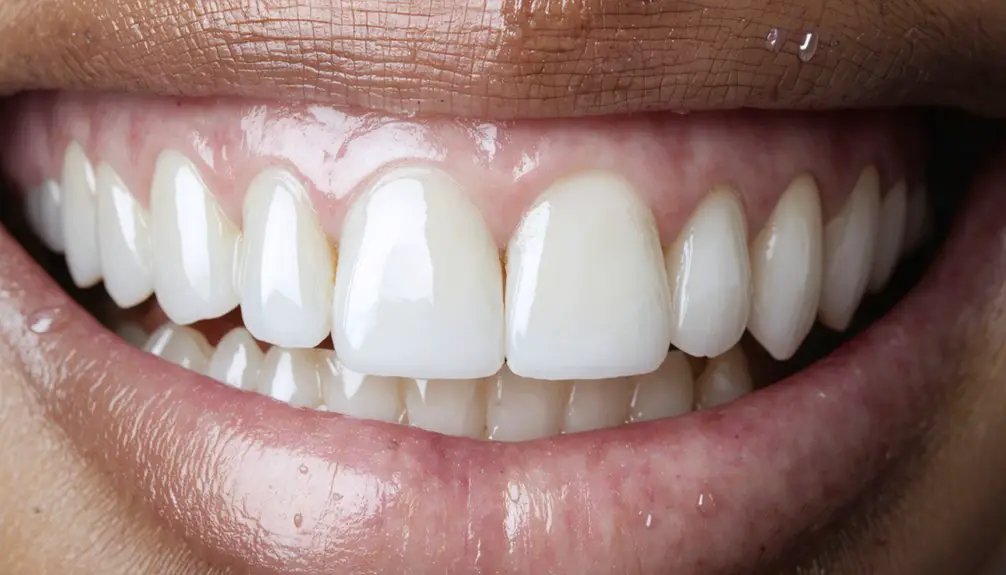
Wine enthusiasts seeking professional-grade stain removal have multiple effective options at their disposal.
To protect your teeth during wine consumption, follow these expert-recommended strategies. Sip water between tastings and pair your wine with cheese, which helps neutralize acid and protect enamel. Wait 30 minutes after drinking before brushing to prevent enamel damage.
For immediate stain management, use specialized wine wipes or a quick water rinse. Consider professional treatments like dental cleaning or custom whitening trays for stubborn stains.
For ongoing enamel care, maintain consistent oral hygiene with fluoride toothpaste and regular dental check-ups. If you’re using at-home treatments, opt for dentist-approved products and avoid combining wine with other staining beverages like coffee or tea.
Frequently Asked Questions
Can Wine Stains Permanently Damage Tooth Enamel Beyond Repair?
Yes, your enamel health can be permanently damaged by wine’s acid erosion and deep staining. You’ll need professional intervention and consistent stain prevention habits to protect against irreversible damage.
How Soon After Drinking Wine Should Whitening Treatments Begin?
Prudently pause for 48 hours after wine before beginning whitening treatments. You’ll protect your enamel and maximize stain prevention. For ideal whitening frequency, wait until saliva naturally neutralizes wine’s acids.
Do Different Types of Wine Cause Varying Levels of Tooth Staining?
Yes, red wine causes the most severe staining due to high tannin levels and chromogens, while white wine’s acidity erodes enamel but stains less. Rosé wines create moderate discoloration between the two.
Are Wine-Specific Teeth Wipes More Effective Than Regular Whitening Products?
Quick as lightning, wine wipes provide immediate stain removal while whitening products work gradually. You’ll find wine wipes more effective for instant results, but whitening products offer better long-term teeth care.
Can Certain Medications Increase Wine’s Staining Effect on Teeth?
Yes, medication interactions can intensify wine staining by causing dry mouth, weakening your enamel sensitivity, and altering oral pH. Antihistamines, antihypertensives, and corticosteroids make your teeth especially vulnerable to stains.
References
- https://bestsmilesdentist.com/teeth-whitening-for-intrinsic-tooth-stains/
- https://cherryhilldentistryllc.com/how-to-prevent-and-get-rid-of-red-wine-teeth-stains-a-thorough-insight-for-a-dazzling-smile/
- https://riahealth.com/blog/how-to-remove-wine-stains-from-your-teeth/
- https://mypenndentist.org/dental-tips/2024/02/13/how-to-remove-stains-from-teeth/
- https://www.darleydentalcare.com/blog/tips-on-teeth-whitening-for-coffee-and-wine-lovers/
- https://pubmed.ncbi.nlm.nih.gov/19761890/
- https://www.davidrizkdds.com/drinking-wine-bad-teeth/
- https://pubmed.ncbi.nlm.nih.gov/15693499/
- https://fittosmile.com/is-drinking-wine-bad-for-your-teeth/
- https://2thdoc.org/wine-and-your-teeth-fine-balance-for-a-healthy-smile/
